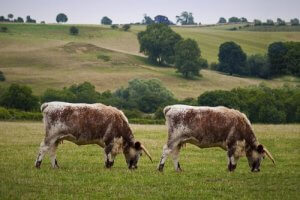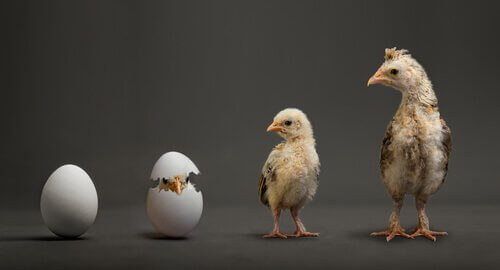Animal Cloning: Advantages and Disadvantages


Written and verified by the lawyer Francisco María García
Animal cloning is one of the scientific advances that’s created the most controversy in recent times. However, the possibility of getting transgenic animals from cloning has played a key role in current medicine.
Treatment for many diseases has advanced considerably thanks to transgenesis, but many people don’t know what it is. In this article, we’ll explain exactly what cloning is, how scientists create transgenic animals and what the advantages and disadvantages of this technique are.
What is animal cloning and how do scientists create transgenic animals?
Animal cloning, also known as transgenesis, is a procedure through which genetic information is transferred from one organism to another. When we’re talking about transgenic animals, we’re referring to the transfer of DNA.
Generally, the code or integral genetic material of an individual isn’t transferred to others. Before performing the procedure, scientists are responsible for selecting, extracting and isolating certain genes.
Descendants created through transgenesis are considered transgenic beings or organisms. That means that transgenic animals are those that show some genetically modified characteristics.

Can all animals be cloned?
In theory, scientists could clone every living being that has a genetic code. So, all animals, even humans, could undergo transgenesis.
To date, scientists have used different species to test animal cloning in laboratories. From small insects and parasites, to fish, birds and reptiles, and even mammals such as goats, monkeys, pigs, sheep, rats, and rabbits.
However, scientists most commonly use mice for transgenic experiments. This is mostly due to their small size, easy handling and how well they adapt to life in captivity.
Dolly the sheep and cloning
Dolly the sheep is probably the most famous transgenic animal in history. They cloned her in 1996. She was the first animal that scientists cloned by transferring the genetic material of the nucleus of adult cells.
Despite the popularity of the case, Dolly wasn’t the first animal to be cloned in the history of science. It was actually frogs who underwent the first process of animal cloning in the 50s.

Dolly’s birth sparked many debates and has popularized cloning around the world. It’s still a very controversial subject today, and even among scientists there is no consensus about the matter.
Advantages and disadvantages of animal cloning
When talking about a subject as controversial as animal cloning and transgenic animals, it’s important to evaluate its advantages and benefits, as well as the possible risks. That way, we can maintain a more rational and balanced perspective on such a relevant topic.
Advantages of animal cloning
- Scientists have developed different experiments to enable and improve transgenesis. This research has greatly expanded our knowledge on the genetic configuration of species.
- By understanding the genome better, they were able to advance the development of new treatments for diseases that affect animals and humans, like cancer.
- Medicine production has also benefited from studies on transgenic animals. Scientists were able to produce the most recent generation of drugs thanks to advances in genetic manipulation.
- Transgenesis could revolutionize the current system of organ and tissue transplants which, at the moment, requires patients to wait for a long time for donations. It can also facilitate the procurement of stem cells for regenerative cell therapies.
- Cloning techniques can also make the creation of gene banks viable. This would prevent many living beings from disappearing from the ecosystem due to human impact.
Disadvantages and risks of genetic manipulation
- Transgenic animals may be more vulnerable to allergic reactions, among other things. This is because of the appearance of certain proteins that weren’t originally in the genetic information.
- We can’t yet predict the exact place that the new gene will occupy in the genome of the transgenic organism. Because of this, it’s not always possible to foresee the final result of the gene transmission from one individual to another.
- We have to be sure to strictly control transgenic animal populations, so they don’t threaten the native species of each ecosystem.
- Using living beings for experiments has an ethical dimension. We have to debate up to what point humans, especially scientists should be interfering with nature itself, and what limits there should be.
Animal cloning is one of the scientific advances that’s created the most controversy in recent times. However, the possibility of getting transgenic animals from cloning has played a key role in current medicine.
Treatment for many diseases has advanced considerably thanks to transgenesis, but many people don’t know what it is. In this article, we’ll explain exactly what cloning is, how scientists create transgenic animals and what the advantages and disadvantages of this technique are.
What is animal cloning and how do scientists create transgenic animals?
Animal cloning, also known as transgenesis, is a procedure through which genetic information is transferred from one organism to another. When we’re talking about transgenic animals, we’re referring to the transfer of DNA.
Generally, the code or integral genetic material of an individual isn’t transferred to others. Before performing the procedure, scientists are responsible for selecting, extracting and isolating certain genes.
Descendants created through transgenesis are considered transgenic beings or organisms. That means that transgenic animals are those that show some genetically modified characteristics.

Can all animals be cloned?
In theory, scientists could clone every living being that has a genetic code. So, all animals, even humans, could undergo transgenesis.
To date, scientists have used different species to test animal cloning in laboratories. From small insects and parasites, to fish, birds and reptiles, and even mammals such as goats, monkeys, pigs, sheep, rats, and rabbits.
However, scientists most commonly use mice for transgenic experiments. This is mostly due to their small size, easy handling and how well they adapt to life in captivity.
Dolly the sheep and cloning
Dolly the sheep is probably the most famous transgenic animal in history. They cloned her in 1996. She was the first animal that scientists cloned by transferring the genetic material of the nucleus of adult cells.
Despite the popularity of the case, Dolly wasn’t the first animal to be cloned in the history of science. It was actually frogs who underwent the first process of animal cloning in the 50s.

Dolly’s birth sparked many debates and has popularized cloning around the world. It’s still a very controversial subject today, and even among scientists there is no consensus about the matter.
Advantages and disadvantages of animal cloning
When talking about a subject as controversial as animal cloning and transgenic animals, it’s important to evaluate its advantages and benefits, as well as the possible risks. That way, we can maintain a more rational and balanced perspective on such a relevant topic.
Advantages of animal cloning
- Scientists have developed different experiments to enable and improve transgenesis. This research has greatly expanded our knowledge on the genetic configuration of species.
- By understanding the genome better, they were able to advance the development of new treatments for diseases that affect animals and humans, like cancer.
- Medicine production has also benefited from studies on transgenic animals. Scientists were able to produce the most recent generation of drugs thanks to advances in genetic manipulation.
- Transgenesis could revolutionize the current system of organ and tissue transplants which, at the moment, requires patients to wait for a long time for donations. It can also facilitate the procurement of stem cells for regenerative cell therapies.
- Cloning techniques can also make the creation of gene banks viable. This would prevent many living beings from disappearing from the ecosystem due to human impact.
Disadvantages and risks of genetic manipulation
- Transgenic animals may be more vulnerable to allergic reactions, among other things. This is because of the appearance of certain proteins that weren’t originally in the genetic information.
- We can’t yet predict the exact place that the new gene will occupy in the genome of the transgenic organism. Because of this, it’s not always possible to foresee the final result of the gene transmission from one individual to another.
- We have to be sure to strictly control transgenic animal populations, so they don’t threaten the native species of each ecosystem.
- Using living beings for experiments has an ethical dimension. We have to debate up to what point humans, especially scientists should be interfering with nature itself, and what limits there should be.
All cited sources were thoroughly reviewed by our team to ensure their quality, reliability, currency, and validity. The bibliography of this article was considered reliable and of academic or scientific accuracy.
- Sosa, M. A. G., De Gasperi, R., & Elder, G. A. (2010). Animal transgenesis: An overview. Brain Structure and Function. https://doi.org/10.1007/s00429-009-0230-8
- Transgenesis, A., Houdebine, L.-M., Transgenesis, A., & Houdebine, L.-M. (2003). Animal Transgenesis and Cloning Animal Transgenesis and Cloning. Recherche. https://doi.org/10.1371/journal.pone.0161006
This text is provided for informational purposes only and does not replace consultation with a professional. If in doubt, consult your specialist.








